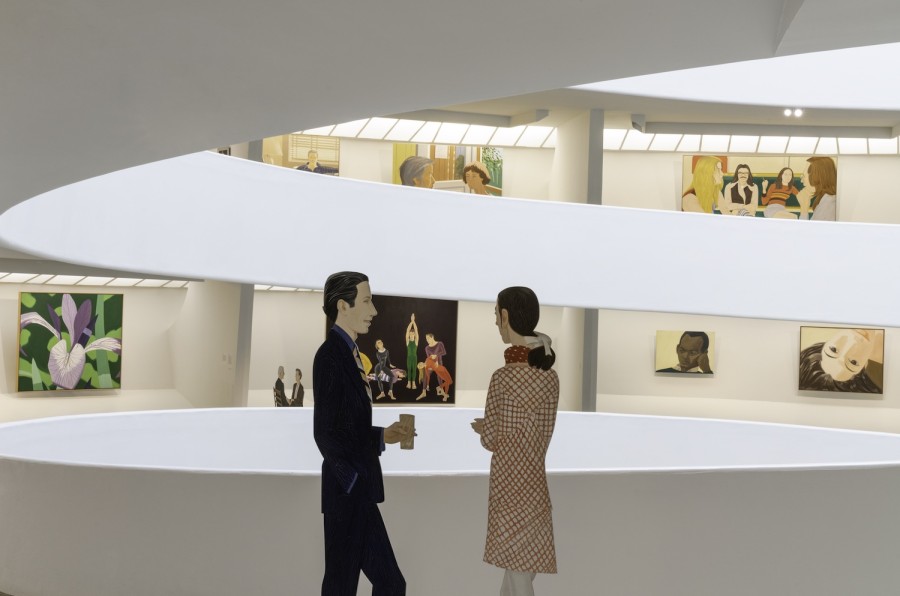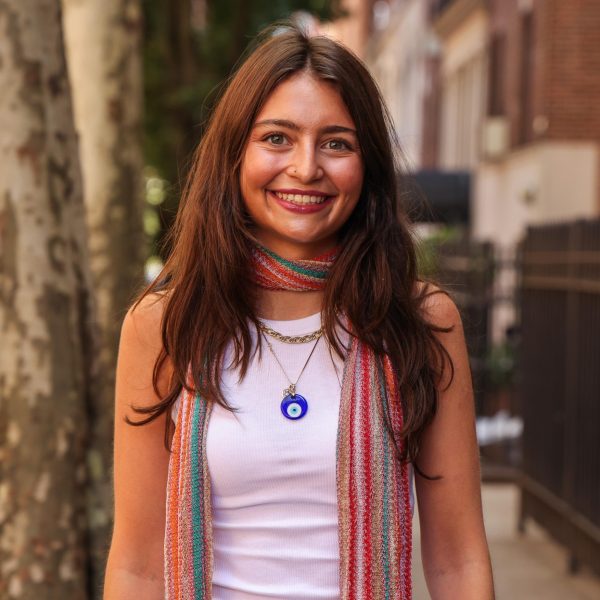Review: ‘Alex Katz: Gathering’ balances natural and urban New York City
The downtown New York artist’s solo exhibition at the Guggenheim Museum is on display until Feb. 20.
Ariel Ione Williams & Midge Wattles
Installation view, Alex Katz: Gathering, Solomon R. Guggenheim Museum, Oct. 21, 2022–Feb. 20, 2023. Photo: Ariel Ione Williams and Midge Wattles. (Courtesy of the Solomon R. Guggenheim Foundation, New York)
February 16, 2023
The entire rotunda of Frank Lloyd Wright’s iconic Solomon R. Guggenheim Museum is full of color and life thanks to artist Alex Katz. Katz is familiar with NYU’s surrounding neighborhoods, and reflects that with a body of work that is easily relatable to its student body — and hard for anyone to resist ogling at.
“Studies from Washington Square,” a collection of five oil paintings, depicts abstract scenes of Washington Square Park in autumn. Small green, brown and orange leaves flutter over the images, showing the inside of the fountain reflecting the corner of the arch — highlighting a pocket of nature in the buzzing city.
An exhibition that includes works that span over 80 years, “Alex Katz: Gathering” presents viewers with an intimate and immersive experience. From Oct. 21, 2022 through Feb. 20 of this year, Katz’s paintings, prints and more are on view. The show, curated by Daskalopoulos Curator of Contemporary Art Katherine Brinson, alongside curatorial assistants Terra Warren and Andrea Zambrano, guides viewers chronologically as they ascend from the bottom of the spherical museum to the top.
Katz was born in Brooklyn in 1927 and quickly moved with his family to Queens. Having attended both Woodrow Wilson High School and Cooper Union, the artist established his talent early on. Katz has been recognized for combining abstract expressionism with imagery reminiscent of American advertising. Today, the views from his downtown New York City apartment and seaside Maine home inspire his work and iconography.
The most striking aspect of Katz’s work is the consistent juxtaposition between city scenes and nature. “Untitled Cityscape 4” is displayed next to “Blue Night” in the exhibit. The massive canvas of “Untitled Cityscape 4” pictures the dark edge of an apartment building against a gray night sky. The atmosphere glitters with light pollution, as bursts of white light bleed through the landscape. “Blue Night” juxtaposes this city scene with its black landscape shapes, nestled against a deep navy sky — with no light to distract the viewer from the vast empty space.
“Cornice,” a 1997 oil-on-linen piece, shows a building facing Katz’s loft that is painted red with rounded windows and architectural moldings. It sits close to “White Impatiens 1,” a vibrant 2012 depiction of pink and green flowers. It’s safe to say that this close-up image of plants is not one that we often see in New York City, especially in such close vicinity to the imagery seen in “Cornice.” This variety in his scenery thrusts the viewer between nature and the city in a way that is unusual for New Yorkers. This exhibition gives us the relief of stepping outside of Manhattan, while still depicting the place we hold near and dear to our hearts.
Katz’s work shows scenes of New Yorkers living their daily lives as well. In “Mr. and Mrs. R. Padgett, Mr. and Mrs. D. Gallup,” 1971, Katz shows us an evening of alcohol and conversation in his SoHo home. The colorful characters, clad in clothing reminiscent of the time period, depict poets Ron Padgett Dick Gallup and their wives, Patricia and Carol, drinking, smoking and talking while seated on a green couch. And Katz’s pen-on-paper “Subway Series” shows various, everyday scenes from the New York City subway, with outlines of riders going about their days.
It would be an injustice to not pay tribute to the artist’s beautiful portraits. Distinguished by their flat and colorful backgrounds, Katz paints seemingly one-dimensional people on a large scale. In the 1970s and 1980s, he used many of the poets of the New York School as subjects of his work. A close-up portrait of poet Ted Berrigan, in the 1967 oil-on-linen piece “Ted Berrigan,” is painted with his hand to his mouth, against a deep blue background.
Katz’s portraiture focuses on expression and detail to create deeply personal images. His use of bright colors complements this seriousness by adding a layer of excitement. To add to the fun, organizers of the exhibit placed Katz’s cut outs around the rotunda, as if these large, painted and cut-out characters were at the exhibit with the viewers. As you walk around the oil-on-aluminum cut-out “Joe 1,” you may feel as if you got to experience the exhibit with him.
“Alex Katz: Gathering” expertly juxtaposes city life against the beauties of nature. While we can’t all escape to a seaside cottage in Maine as Katz does, we can still pay attention to the nature around us. We can watch as the leaves change color, and as the spring flowers bloom. This exhibition tells us to appreciate the little things, and it could not be executed in such a wonderful fashion without Katz’s masterful artistry and sheer talent.
Contact Alexa Donovan at [email protected].

























































































































































